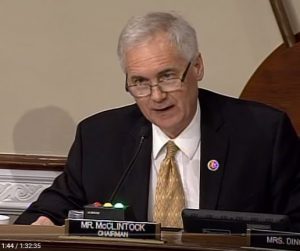McClintock: The State Of Water Supply Reliability
Congressman Tom McClintock provided an opening statement on the state of water supply reliability in the 21st Century during last week’s Subcommittee on Water, Oceans and Wildlife Oversight Hearing.
McClintock was Friday’s KVML “Newsmaker of the Day”. Here are his words:
“According to the EPA, since 1901, global precipitation has increased at an average rate of roughly a tenth of an inch per decade, while precipitation in the contiguous 48 states has increased at a rate of nearly 2/10ths of an inch per decade. Globally, annual rainfall alone produces roughly 50,000 gallons of freshwater every day for every man, woman and child on this planet.
The problem is that this abundance of freshwater is unevenly distributed over time and space. Throughout the 20th Century, it was the policy of this government to guarantee abundant water for all the people and regions of our country. We built reservoirs to transfer water from wet years to dry years and we built canals to transfer water from wet regions to dry ones. By doing so, we made the deserts bloom, protected our communities from floods and droughts and opened up vast tracts of land to support a prosperous population made possible by water abundance.
Sadly, these policies were reversed over the last 45 years. In my region, four years of drought, combined with massive pulse flow water releases mandated by environmental laws, drained our reservoirs nearly to dead-pool levels. The next year, an atmospheric river opened up, requiring the loss of massive amounts of water to the ocean because we had no place to store it – not for lack of suitable sites, but for inaction in using them.
The climate is constantly changing, which requires constant adaptation. Up until 5,000 years ago, the Sahara was one of the wetter regions of our planet, with frequent monsoons that produced the largest freshwater lake in the world. During the Roman Warm Period, much of the Roman grain supply was grown in North Africa.
The foresight of America’s 20th Century water engineers should be more apparent today. In the Modern Warm Period, water will be stored for less time as snow in the mountains, which means that without new reservoirs to capture this runoff, it will be lost to the ocean.
During the last several congresses, the House sent major legislation to the Senate to expedite and reform the permitting process that has made the construction of new reservoirs endlessly time consuming and ultimately cost-prohibitive. Unfortunately, the Senate failed to act.
As one example, the Shasta Dam was built to an elevation of 600 feet and stores more than 4 ½ million acre-feet of water. But it was designed to an elevation of 800 feet. The difference is 9 million acre-feet of water storage. Yet less than 20 feet of elevation – about 600,000 acre-feet of additional storage – has been stalled for decades in an endless cycle of environmental studies with no end in sight.
Droughts are nature’s fault. They happen. But water shortages are our fault. They are a choice we made when we stopped building adequate storage to meet the needs of the next generation.
We are told that reservoirs are old-fashioned, and that we must look to solutions like conservation, recycling and desalination. We need to understand what that actually means.
Conservation does not add a drop to our water supply – it merely copes with a shortage that our own policies have imposed. And there is a limit to how much conservation can be mandated before it begins to have a significant negative impact on the quality of life for our people. Californians are soon going to get a major lesson in this when mandated year-round water rationing signed by Gov. Brown takes effect in a few years.
Recycling and desalination make sense in deserts where water is scarce and can’t be imported. Fortunately, most regions of our country are blessed with abundant water. According to the California Energy Commission, surface water storage costs between $400 and $800 per acre foot while water desalination costs $1,800 to $2,800 per foot and water recycling $1,200 to $1,800 per foot. In other words, storing water before it is lost to the ocean costs a mean of $600 while reclaiming it once it’s been lost to the ocean costs $2,300. Water desalination is a great idea if you don’t mind your water bill quadrupling.
We should be looking at the most cost-effective ways to produce water abundance – not the most expensive. That is the difference between abundance and scarcity – the difference between prosperity and rationing — and the difference between the policies before us today.”
The “Newsmaker of the Day” is heard every weekday morning at 6:45, 7:45 and 8:45 on AM 1450 and FM 102.7 KVML.

